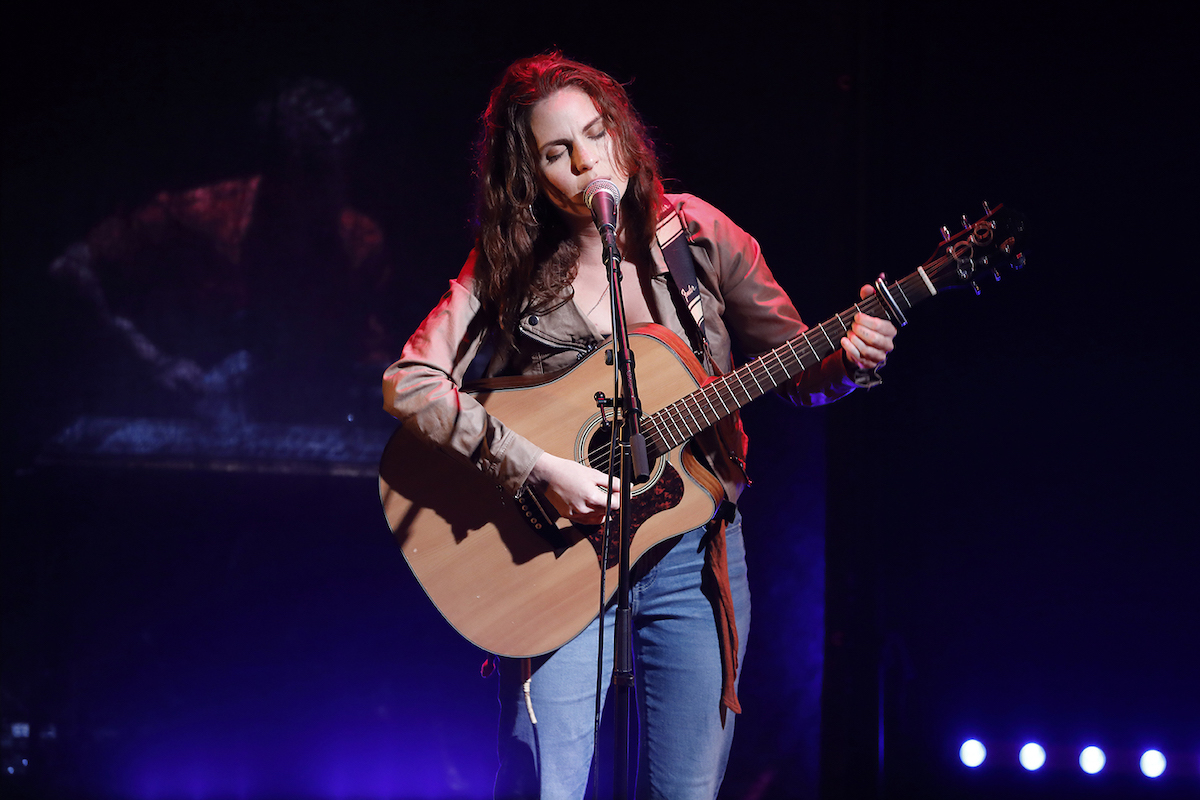Cutting all the way up from Adelaide to Darwin on the pub music circuit, Raye and Dan ignite a relationship that is part passion and part unleashing of old wounds. These two lovers are not good for each other, but do they need each other right now?
Originally conceived as a film script, John Harvey’s three-hander musical play Heart is a Wasteland has been remounted, while the nation awaits to see how the Albanese government honours its commitment to the Uluru Statement from the Heart, including a constitutionally enshrined Indigenous Voice to Parliament.

Monica Jasmine Karo as Raye in Heart is a Wasteland, Ilbijerri Theatre Company. PHoto © Fiona Morrison
Harvey places characters Raye and Dan at the heart of broader truths “actively suppressed” across Australia, and Ilbijerri Theatre Company Artistic Director Rachael Maza has reimagined the work, five years after its premiere production at Malthouse Theatre starring Ursula Yovich and Aaron Pedersen.
She has cast a pair from a new generation in the main roles. “It was a very conscious decision to cast them 10 to 15 years younger than Ursula and Aaron,” says Maza, with Gunai/Gunditjmara actor Monica Jasmine Karo as country singer Raye and Yidinji/Meriam actor Ari Maza Long as Dan. (Dion Williams was cast as Dan in seasons cancelled last year due to lockdowns and border restrictions.)
Prior to rehearsals, Maza sat down with Harvey, who told her the Dan character was inspired by his own experiences working in Indigenous communities, when he was about 25. “I thought, ‘All right, we’re casting down in age’,” says Maza, with a laugh.
“It’s a really subtle balance between being old enough to have got some history and some baggage, but still naïve enough to fall in love after three days and to believe ‘doing these pub circuits is going to get me somewhere’.”
Maza says the work “speaks so beautifully to the complexity of what it is to be a contemporary blackfella. Here we have two young blackfellas who carry this generational trauma, through the 200-plus years of colonisation and which continues to live within us today. Their need for healing speaks to the need of this country for healing.”
John Harvey previously wrote in the program notes for the premiere production in 2017: “Much of our country is carrying buried wounds and truths that have been actively suppressed. And whilst these things may not be spoken about, the energy of these acts spills into our lives without recognition and healing.”
“How do we grow a country physically and spiritually when we can’t acknowledge or shed light on our wounds or sit with the pain?”
Karo, joining the interview via her mobile phone, says Raye is constantly struggling with being a travelling musician and single mother, and not having her child with her.
“There’s a constant heartache and pain Raye has to face,” says Karo. “These characters are coming into their Saturn return – 25, 26 going on 30 – and having to grow up so they can heal and be better parents, or in Raye’s case, a better mother.”
“She has a difficult past. A lot of that is, as Rachael says, intergenerational trauma, and having a child young and wanting to step back into her son’s life as a young Aboriginal boy; what is that future going to look like for him? I’m a mother myself, I have a four-year-old son, and that plays on my mind, obviously.”
“What is really important here, is showing the diversities of our people, our mob, and recognising that we are multicultural. We have other bloodlines, obviously, because it’s been 230 years since colonisation.”
“I’m a Gunai and Gunditjmara woman on my father’s side and recognise my Slovenian, Irish, multicultural heritage within myself. We stand proud with who we are in this story, with our diversity as contemporary Indigenous peoples.”
Maza is interested in theatre as the “in-between place” where audiences imagine the scene, removing extraneous furnishings or literal room settings as much as possible, with the help of the designers.
Video designer Sean Bacon employs an abstracted chalk or charcoal-style animation in the production, drawing for audiences what is going on inside the character’s minds, rather than showing landscape and countryside. “It almost becomes an adult child book version of their story, as the characters imagine their story,” says Maza.
Actor, musical director and arranger Gary Watling, a Wiradjuri man, has kept all of Lydia Fairhall’s songs written for the play, but there is more music in this reimagined production, because numbers cut from the original staging have been reinstated.
Maza says the play speaks to our humanity, without being overt or didactic. “These characters are so rounded, so messy but so beautiful,” she says.
“When Australia is able to acknowledge our humanity, our full, complete humanity on this place, on this country, as the first peoples of this country, and truly sit in the presence of this extraordinariness, our ancient and incredible legacy that we have, then that relationship, that Voice to Parliament, makes sense.”
“It’s a no-brainer. Why wouldn’t you be sitting at the table with us in the future of this country?”
Heart is a Wasteland plays at Gippsland Performing Arts Centre on 29 July, Bega Valley Commemorative Civic Centre 4 & 5 August, and Arts Centre Melbourne’s Fairfax Studio 25–27 August.











Comments
Log in to join the conversation.